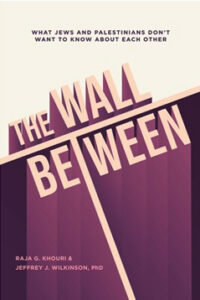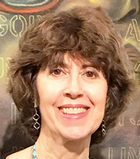The Wall Between: What Jews and Palestinians Don’t Want to Know About Each Other
 At a time when the rhetoric around Israel/Palestine is at a fevered pitch throughout all aspects of daily life, this lucid and succinct book couldn’t be more needed. Raja G. Khouri, a Palestinian, and Jeffrey J. Wilkinson, a Jew, are the co-authors who parse the disconnect between the “metanarratives” of the Holocaust and the Nakba. Khouri and Wilkinson use the “psychosocial energies” of “identity, trauma, and victimhood” (ITV) to demonstrate why each group has been unable and unwilling to hear the vital concerns that form the psychological framework of “the Other’s” mindset.
At a time when the rhetoric around Israel/Palestine is at a fevered pitch throughout all aspects of daily life, this lucid and succinct book couldn’t be more needed. Raja G. Khouri, a Palestinian, and Jeffrey J. Wilkinson, a Jew, are the co-authors who parse the disconnect between the “metanarratives” of the Holocaust and the Nakba. Khouri and Wilkinson use the “psychosocial energies” of “identity, trauma, and victimhood” (ITV) to demonstrate why each group has been unable and unwilling to hear the vital concerns that form the psychological framework of “the Other’s” mindset.
The text examines the shaping of individual narratives, the competition between Israeli and Palestinian perceptions, and how propaganda implements a weaponization of fears. Altogether, these factors prevent forward movement toward a new paradigm.
The key to assessing how the two diasporas react to specifics is how their particular ITV realities impact them. For example, Palestinians view their resistance to the Occupation as a fight for national hopes and aspirations, while Jews regard it as a threat of annihilation.
Readers are challenged to check their visceral reactions to the material and question if their identity is the foundation for shaping their response. Is a previous ordeal being reactivated? Is the aggrieved mentality prevalent?
Underscoring that it is through exposure to unfamiliar ideas that growth occurs, the authors acknowledge an understandable opposition to “uncomfortable information,” using the term “confirmation bias” to define how we seek to connect with insights that agree with our established notions. Rather than remaining in lockstep with our tribe, Khouri and Wilkinson call for “widening the circle of understanding.” They recognize that in the reevaluation process, a blind commitment to long-held positions and beliefs will have to be relinquished. They term it the “safetyism” of thought emanating from the tribal collective memory.
Khouri and Wilkinson posit, “Our argument is that our views on antisemitism, Zionism and the Nakba, or Palestinian resistance are skewed by our need to seek out the familiar and resist the unfamiliar.” As they explain, each group clings to its “social identity,” including past and current traumas.
A critical point Khouri and Wilkinson underscore is that in Israel/Palestine, Jews have secured the “power position,” contributing to “equity gaps.” Yet their actions remain formulated on seeing the Palestinians as a threat. They also highlight the emotional tension experienced by North American Jews regarding the shift in the ongoing role of Jews from victims…to victimizers.
Palestinians face ongoing oppression, while for Jews, the potential for catastrophe is perpetual. Both ascribe to the ingrained belief that what is past is prologue. This is seen in the Jewish response to the October 7 Hamas attack, and by Palestinians to the displacement resulting from the siege on Gaza. As Khouri and Wilkinson state, “Our ‘victim beliefs’ are a product of the re-wounding.”
A complete chronological/historical backstory of antisemitism and a review of post-World War I maneuvering by victorious nations in the wake of the breakup of the Ottoman Empire is outlined. These pages demonstrate how a security solution for Jews in their ancient homeland, in the shadow of the Holocaust, became a reality of dispossession for Palestinians.
Khouri and Wilkinson advocate for a commitment to “deep listening,” stressing that engaging with stories from the other side will allow a shift from prioritizing internalized viewpoints to being open to new perspectives despite the angst it triggers. They appeal to individuals to move from the zone of their exclusive tragedies to a place that embraces the goals of justice and equality for both populations. They offer these initiatives as a “partial antidote” to “interrupt the status quo” and to create a catalyst to shift the dialogue from “Who is right to what is right?”
After the horrors of the present “war,” there will be an opportunity for innovative stakeholders and dialogue to come to the fore, opposing the usual options for “the day after.” Evolving groups on the ground are getting traction as they develop models of cooperation and co-action between Israeli Jews and Palestinians, both inside the Green Line and for the whole territory. There is strong agreement that only a political solution, not violence, is the way to move into a future that will guarantee freedom and humanity for all.
They will need the support of their respective societies to dismantle the physical and metaphorical walls.
A version of this article originally appeared in the Winter edition of Fellowship Magazine.




